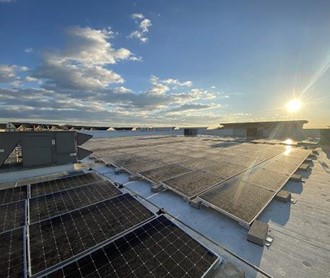
A TPO roof membrane is a great choice for your home. It doesn't absorb heat which will reduce cooling costs. Another is that it is easy to install. It comes in a single-ply white membrane. TPO roof membranes offer many benefits. They are also very environmentally friendly.
Single-ply, single-ply white membrane
TPO membranes include a special mix polymers such as ethylene rubber or polypropylene. These polymers form a waterproof membrane. It is applied by mechanical fasteners at its seams. It is strong, durable, eco-friendly, and long-lasting.
TPO roofing has been a popular choice for commercial and residential applications since its inception. It has a wide variety of color options and energy-saving capabilities. These features enable it to be used in a wide range of designs. TPO membranes can come in many colors.

Reflects heat rather that absorbing it
A material that reflects heat instead of absorbing it is called a reflective material. Light-colored materials like snow and ice reflect heat better than dark ones. On the other hand, dark materials absorb heat and radiate it back into the atmosphere. This effect is especially important for the Arctic, where melting sea-ice will likely accelerate climate change.
How much heat an object radiates depends on the color it is. White objects are the best at reflecting most of what energy is radiated to them. Darker colors absorb energy more efficiently and convert it to heat energy. Cool-colored objects absorb the least amount of light, which means that they do not have enough heat energy to raise the temperature.
Lower cooling costs
TPO roof membrane is a great solution for warmer climates. It can be manufactured in many different colors and has an excellent UV resistance. TPO offers high levels of design flexibility. The flexible material can be shaped to fit any aesthetic style, while also delivering high levels of energy efficiency.
Another advantage of TPO roof membrane is its light weight. TPO roofing materials are manufactured with wider sheets and require fewer seams, making them less cumbersome to install. It also requires less experience to install than some other roofing materials. TPO roof installations should only be performed by professionals.

Easy to Install
TPO membranes are made from a mixture of polymers, typically polypropylene and polyethylene rubber. They are strengthened with a special fabric. They can be installed three ways: mechanically attached, adhered, and ballasted. TPO roofs with mechanical attachments need to be fastened at the seams. These fasteners guarantee strong performance in high-wind conditions. You can also choose from a variety of thicknesses to make it easier for you to find the right one for your home.
Once you've decided on the TPO roofing membrane that suits your home best, learn how to put it in place. The first step in installing insulation is to do so. This will protect the roof from water vapor and improve energy efficiency. The next step involves attaching the cover board. This step is recommended by most installers to use OSB or 5/8" plywood. You'll also need to sand any sharp edges before attaching the membrane.
FAQ
Who pays for this service?
The SCA identifies who is responsible for paying the service. If the service provider is not paid in full, it may have grounds to claim compensation through the courts.
Is a contract of service a warranty?
Service contracts are not warranties. It is an agreement between the parties to exchange goods and/or services. If the product is not performing satisfactorily, the customer agrees with the seller to cover the repair or replacement costs. This contract is also called a maintenance contract.
Do I need a lawyer to sign my Service Agreements?
No. You don't need a legal representative to sign your service agreements. You may wish to appoint one for a precautionary reason.
A legal representative is someone who acts on behalf of another person. If you are a contractor you might want to appoint someone as your professional representative.
This could mean hiring a solicitor or accountant. It could also be the appointment of someone to look out for your business interests.
In most cases, the client is responsible for appointing a legal agent. Sometimes, however a vendor will hire a legal representation.
In each case, having a legal representation means you are legally protected.
How much does it set you back to get building permission?
It depends on the state you are in and the complexity of the proposal. It may also depend on whether you apply for permission to build or extend your current house. The application process can take several months, so be prepared to wait until everything is finalized.
Statistics
- Don't take their anger personally, they are mad about the situation 99% of the time. (activatemylicense.com)
- While we offer all our high-quality services at competitive prices, we know that many who need our services are on fixed incomes, so we offer a 10 percent discount for seniors and military members. (homeservicecontractorsinc.com)
- (v) Place or places of performance of the prime contract and first-tier subcontracts estimated at $10 million or more, if known. (acquisition.gov)
- (d) Contractor disputes related to compliance with its obligation shall be handled according to the rules, regulations, and relevant orders of the Secretary of Labor (see 41 CFR60-1.1). (acquisition.gov)
- Depending on the client's trustworthiness and financial stability, a deposit is usually 10 to 50% of the total contract amount. (lawdepot.com)
External Links
How To
What should a Service Agreement include?
Service agreements (SAs) are essential for any business relationship. It will outline what you expect and how it will be achieved. It also outlines when and where the other party must fulfill its contractual obligations.
A successful SA must include these key elements:
-
Both parties must agree on the scope and required services.
-
Details about the payment terms.
-
An agreed price for the project.
-
Any additional charges, like VAT, etc.
-
Whether there is anything else that needs to be discussed.
-
Who will be held responsible for any problems that may arise on the job?
-
How disputes can be resolved
-
What happens to a contract breached by one party?
-
What happens in case of dispute.
-
When does the contract go into effect?
-
What happens when one of the parties doesn't perform?
-
What length of time will you be required to pay invoices
-
Who pays for things like travel expenses.
-
Where the money came from.
-
What happens if a client changes his mind?
-
What happens if the supplier doesn't turn up.
-
Who has the right to enter the site during construction?
-
What happens if the client cancels the project?
-
What happens if a product is not as described?
-
What happens when the manufacturer refuses supply?
-
What happens if equipment fails?
-
What happens if the project takes more time than anticipated?
-
What happens when the work is not completed within the specified timeframe?
-
What happens to the project if it isn't up-to-standard?
-
What happens if the cost exceeds?
-
What happens if materials are not delivered on time?
-
What happens when the material arrives damaged.
-
What happens if products do not meet the standards?
-
What happens when the job is cancelled before completion?
-
What happens if the business goes under?